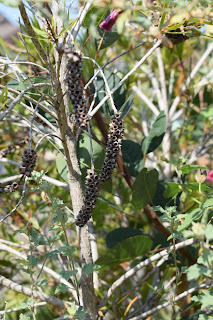No need to comment on the oppressive heat this week. Scorching. Apart from how it impacts other parts of our lives, it certainly is tough on our gardens. It's at times like these that the value of mulching is brought to the fore. Mulching protects roots from burning and it also preserves water. It also helps to diffuse the heat, even absorbing some of it. All of which protects our plants.
Okay, enough. Hope you're staying cool. Here are some recent garden photos. Enjoy.
Cypella peruviana. One of the most gorgeous of all bulb flowers.
Erica speciosa. This heather blooms nearly year round.
Calibrachoa variety. Million Bells are always a great way to add color to a sunny spot.
Oregon White Oak (Quercus garryana). Still small but already displaying handsome leaves.
Rudbeckia Indian Summer. This variety has especially large flowers.
This mixed succulent bowl is coming along nicely.
For those of you who grow Eriogonum species, it's a good idea to leave the flowers on the plant. This allows seedheads to form and they will attract a variety of smaller songbirds interested in that seed.
Here's a new Calluna (C. Amethyst). As you can see, it's in full bloom, attracting both bees and hummers to its flowers.
Not the best photo but wanted to share the lovely butter yellow flowers of my Mimulus 'Lemon Yellow.'
Speaking of seedpods, here are the curious ones on my bottlebrush shrub (Callistemon viminalis).
I'm not sure which Oxalis this is, other than it's one of the shamrock leaf types.
A new addition to my garden, this Agave pygmaea offers up a lovely steel blue color.
Meanwhile, this Echeveria species showcases lovely red, orange and green tones.
Though not showy yet, here's the developing fruit on my Buddha's Hand citrus tree. It will double in size, develop more pronounced 'fingers' and get a bright yellow.
Chamaecyparis variety. I can't remember now which Chamaecyparis this one is. Perhaps 'Snow.'
My young Japanese Black pine (Pinus thunbergii) has produced its first tiny cone. Here it is. I have begun to collect pine trees, especially any dwarf varieties.
There are a number of plants called 'plumbago' but one very popular ground cover one is Ceratostigma plumbaginoides. Here is mine, showing its brilliant blue flowers.
Here's another photo of my floriferous Snapdragon Chantilly Peach.
Today's 'name that plant' quiz is the plant pictured above. Any guesses? If you thought it to be a Salvia you are close. It's a type of Pitcher Sage, this one Lepechinia bella. 'Bella' indeed!
Lantanas are common but that doesn't mean they aren't pretty.
Begonia odorata 'White.' Though it's not fragrant like many B. odoratas, this variety still produces a large and lovely flower.
Pelargonium 'Claire.' A gift from a friend, this flower features two luscious shades of red.
Coleus variety. A real workhorse, coleus will often last until January in milder zones like Oakland.
Begonia rex Festive Celebration. Like many rex types, it features a curving pattern and a darker center mirrored in its edging.
Asplenium trichomanes. This dwarf fern seems happy in its shady location.
Here are three recent tiles. The two in the back are Turkish Iznik tiles and the front one is of a Celtic knot.
My Firewheel tree (Stenocarpus sinuatus) is healthy but I'm waiting on the showy flowers to appear.
Neoregelia 'Pink Debbie.' Pink indeed, the new leaves on this bromeliad are a vivid orchid pink.
Begonia 'Irene Nuss.' Sought after more for its colorful scalloped leaves, this begonia's flowers are nonetheless a lovely light pink.






























No comments:
Post a Comment